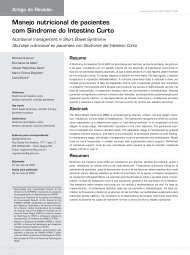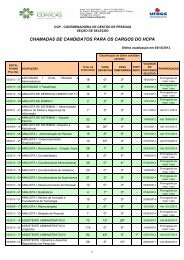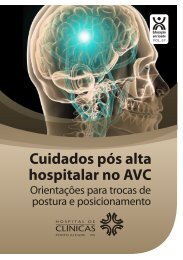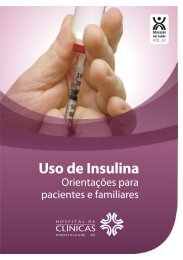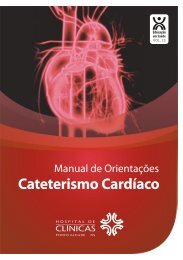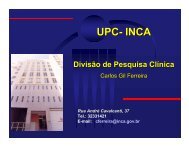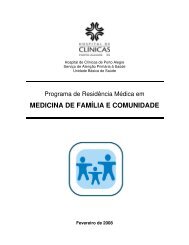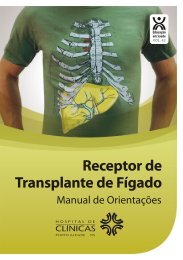Anais da 27º Semana CientÃfica - Hospital de ClÃnicas de Porto Alegre
Anais da 27º Semana CientÃfica - Hospital de ClÃnicas de Porto Alegre
Anais da 27º Semana CientÃfica - Hospital de ClÃnicas de Porto Alegre
You also want an ePaper? Increase the reach of your titles
YUMPU automatically turns print PDFs into web optimized ePapers that Google loves.
91<br />
Revista HCPA 2007; 27 (Supl.1)<br />
mandibulectomia segmentar com extensa ressecção <strong>de</strong> partes moles adjacentes. Materiais e Métodos: Paciente portador <strong>de</strong><br />
carcinoma epi<strong>de</strong>rmói<strong>de</strong> grau I, com nódulos cervicais suspeitos para metástase. Apresentava ain<strong>da</strong> grave infestação larval por<br />
Cochliomyia hominivorax e infecção bacteriana. Após antibioticoterapia e exames complementares, foi submetido a ressecção<br />
cirúrgica <strong>da</strong> lesão com margens amplia<strong>da</strong>s e esvaziamento cervical. Para reconstrução utilizou-se dois retalhos combinados,<br />
miocutâneo peitoral e <strong>de</strong> Converse. Conclusão: O carcinoma epi<strong>de</strong>rmói<strong>de</strong> <strong>da</strong> boca tem como característica invasão local<br />
progressiva dos tecidos moles adjacentes e disseminação linfática para região cervical. Quando tratado precocemente o câncer <strong>de</strong><br />
boca é facilmente curável sem a necessi<strong>da</strong><strong>de</strong> <strong>de</strong> ressecções amplas e mutiladoras. Em cirurgias agressivas <strong>de</strong> cabeça e pescoço a<br />
utilização dos retalhos miocutâneos para reconstrução é amplamente emprega<strong>da</strong> pois estes apresentam excelente perfusão e<br />
segurança. Neste caso utilizou-se a combinação <strong>de</strong> dois tipos <strong>de</strong> retalho <strong>de</strong>vido à extensão <strong>da</strong> ressecção e porque o retalho <strong>de</strong><br />
converse no homem permite o crescimento <strong>de</strong> pêlos, ocultando o <strong>de</strong>feito cirúrgico.<br />
PERFIL E LETALIDADE DOS CASOS DE CÂNCER DE LARINGE ATENDIDOS NO HOSPITAL DE CLÍNICAS DE<br />
PORTO ALEGRE ENTRE 1998 E 2003<br />
MÁRCIO EDUARDO BROLIATO; PRISCILLA FERREIRA; CLAUDETE DE OLIVEIRA; JAIR FERREIRA<br />
O câncer <strong>de</strong> laringe tem uma distribuição universal e representa cerca <strong>de</strong> 1% <strong>da</strong>s neoplasias malignas. O objetivo do estudo foi<br />
analisar as características <strong>de</strong>ssa neoplasia nos pacientes atendidos em um hospital <strong>de</strong> referência. Para este estudo <strong>de</strong> coorte<br />
histórica foram usados os <strong>da</strong>dos do Registro <strong>Hospital</strong>ar <strong>de</strong> Câncer do <strong>Hospital</strong> <strong>de</strong> Clínicas <strong>de</strong> <strong>Porto</strong> <strong>Alegre</strong>, que registra todos os<br />
casos <strong>de</strong> neoplasias malignas diagnosticados a partir <strong>de</strong> 1998. Para a análise estatística foi utilizado o programa Epi Info. Entre<br />
1998 e 2003, foram registrados 277 (2,7% do total) casos <strong>de</strong> câncer <strong>de</strong> laringe. Tinha 86,3% <strong>de</strong> homens e a i<strong>da</strong><strong>de</strong> média foi <strong>de</strong><br />
58,7 anos. Em relação à topografia, 18,4% acometeram glote, 18,4% supraglote, 0,7% subglote, 6,1% tinham localização<br />
sobreposta e 56,3% não tinham localização especifica<strong>da</strong>. No diagnóstico histológico prevaleceu carcinoma epi<strong>de</strong>rmói<strong>de</strong> (91,7%),<br />
seguido <strong>de</strong> a<strong>de</strong>nocarcinoma (2,5%). A letali<strong>da</strong><strong>de</strong> em 2 anos, entre 277 pacientes acompanhados por esse período, foi <strong>de</strong> 28,5% e<br />
em 5 anos, entre 159 pacientes acompanhados por esse período, foi <strong>de</strong> 37,0%. O sexo feminino foi fator protetor para óbito em 2 e<br />
5 anos (RR=0,79; IC 95%: 0,68-0,92; p=0,02 e RR = 0,74, IC 95%: 0,58-0,94; p=0,046; respectivamente). Presença <strong>de</strong> metástase<br />
foi fator <strong>de</strong> risco para óbito em 2 anos (RR=1,96; IC 95%: 1,32-2,92; p=0,003). Não houve diferença significativa entre as faixas<br />
etárias para sobrevi<strong>da</strong> em 2 e 5 anos (p=0,515 e 0,386, respectivamente). Os <strong>da</strong>dos mostram uma incidência maior em homens e<br />
uma sobrevi<strong>da</strong> baixa em 2 e 5 anos em relação à outros tumores. Sexo feminino mostrou-se fator protetor e presença <strong>de</strong> metástase,<br />
fator <strong>de</strong> risco para a ocorrência <strong>de</strong> óbito. A partir <strong>de</strong>sse estudo, baseado em <strong>da</strong>dos locais, po<strong>de</strong>-se aperfeiçoar o atendimento dos<br />
pacientes com câncer <strong>de</strong> laringe.<br />
PREVALENCE OF THE CHEK2 1100DELC GERMLINE MUTATION IN BRAZILIAN FAMILIES WITH THE<br />
HEREDITARY BREAST AND COLON CANCER (HBCC) SYNDROME.<br />
JAMILE ABUD; INGRID PETRONI EWALD; SILVIA LILIANA COSSIO; FERNANDO REGLA VARGAS; MIGUEL<br />
ÂNGELO MOREIRA; EDENIR INÊZ PALMERO; PATRÍCIA KOEHLER SANTOS; PATRÍCIA ASHTON-PROLLA;<br />
HECTOR YURI CONTI WANDERLEY; JOÃO CARLOS PROLLA.<br />
Introduction: An estimated 5-10% of all breast cancers (BC) and 10 -20% of all colorectal cancers (CRC) are associated to<br />
hereditary predisposition and its recognition is of great importance. The Brazilian State of Rio Gran<strong>de</strong> Do Sul (RS) has one of the<br />
highest BC inci<strong>de</strong>nce and mortality rates. CRC is also one of the most common tumors in women from this region in the country.<br />
In families with both BC and CRC, germline mutations in the CHEK2 gene may be present. This gene enco<strong>de</strong>s a cell cycle<br />
checkpoint kinase that plays an important role in the DNA <strong>da</strong>mage repair pathway, activated mainly by the ataxia telangiectasia<br />
mutated (ATM) gene in response to double-stran<strong>de</strong>d DNA breaks, which result in phosphorylation of p53 and BRCA1. A<br />
common germline mutation in CHEK2, 1100<strong>de</strong>lC, has been <strong>de</strong>scribed as a low penetrance mutation in a significant number of<br />
families with HBCC and is also associated with increased risk of contralateral BC. Objectives:The goal of this study is to<br />
<strong>de</strong>termine the prevalence of the CHEK21100<strong>de</strong>lC mutation in a sample of 116 Brazilian individuals with clinical criteria for the<br />
hereditary breast and colorectal syndrome (HBCC). Patients and Metod: DNA samples obtained from peripheral blood will be<br />
submitted to PCR amplification of the gene using a Long-range PCR strategy with subsequent mutation <strong>de</strong>tection by: direct<br />
sequencing of the amplified fragments and mutation screening with DHPLC followed by sequencing of the variants. A positive<br />
sample is used in all experiments as an internal control. Results and Conclusion:Preliminary results of the first 28 unrelated<br />
patients analysed resulted in the i<strong>de</strong>ntification of the <strong>de</strong>letion in one case. Results of a larger sample of women will be presented<br />
and the impact of this type of genetic test will be discussed.<br />
O TEMPO DE DUPLICAÇÃO DO PSA É FATOR PREDITIVO DE CONTROLE BIOQUÍMICO PARA RADIOTERAPIA<br />
CONFORMACIONAL TRIDIMENSIONAL DE SALVAMENTO NO CÂNCER DE PRÓSTATA?<br />
CAROLINE SARTORI; CORRÊA JRM, PEREIRA-LIMA MN, BARLETTA DV, FERREIRA PRF<br />
INTRODUÇÃO: Não há consenso quanto ao critério <strong>de</strong> <strong>de</strong>finição <strong>de</strong> falha bioquímica após prostatectomia radical. É possível que<br />
o tempo <strong>de</strong> duplicação do PSA (TDPSA) se correlacione com a chance <strong>de</strong> controle pós-radioterapia <strong>de</strong> salvamento.<br />
OBJETIVO:Avaliar se o TDPSA é fator prognóstico para controle bioquímico pós-radioterapia <strong>de</strong> salvamento em pacientes<br />
operados por câncer <strong>de</strong> próstata no <strong>Hospital</strong> <strong>de</strong> Clínicas <strong>de</strong> <strong>Porto</strong> <strong>Alegre</strong>. MÉTODO: Análise retrospectiva dos pacientes com<br />
recidiva bioquímica pós-operatória submetidos a radioterapia conformacional tridimensional (66Gy/7 semanas) entre janeiro <strong>de</strong><br />
2002 e <strong>de</strong>zembro <strong>de</strong> 2006. Correlacionamos o TDPSA em meses com a duração <strong>da</strong> remissão bioquímica pós-radioterapia<br />
utilizando o método <strong>de</strong> Kaplan-Meier. O critério adotado para recidiva bioquímica pós operatória foi o <strong>de</strong> PSA ≥ 0,5 ng/mL e o <strong>de</strong><br />
controle bioquímico pós-radioterapia foi o <strong>de</strong> PSA < 0,5 ng/mL. O ponto <strong>de</strong> corte do TDPSA foi estabelecido em 9 meses.<br />
RESULTADOS: Incluídos 105 pacientes com i<strong>da</strong><strong>de</strong> média <strong>de</strong> 63,7 anos, tempo mediano <strong>de</strong> seguimento <strong>de</strong> 28,2 meses. A<br />
concentração mediana do PSA prévio à cirurgia foi 11,2ng/mL e o nadir pós-operatório mediano, <strong>de</strong> 0,31ng/mL. Falha bioquímica<br />
do PSA foi observa<strong>da</strong> em 17 (17,8%) dos 73 pacientes com TDPSA < 9 meses e em 7 (24,1%) dos 29 com TDPSA ≥ 9 meses




